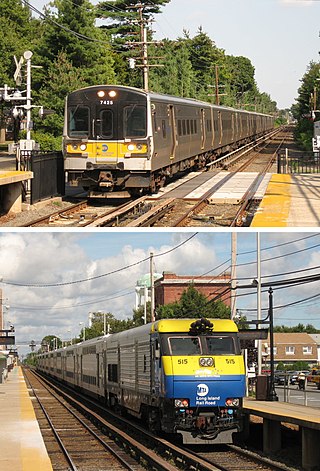
The Long Island Rail Road, or LIRR, is a railroad in the southeastern part of the U.S. state of New York, stretching from Manhattan to the eastern tip of Suffolk County on Long Island. The railroad currently operates a public commuter rail service, with its freight operations contracted to the New York and Atlantic Railway. With an average weekday ridership of 354,800 passengers in 2016, it is the busiest commuter railroad in North America. It is also one of the world's few commuter systems that runs 24/7 year-round. It is publicly owned by the Metropolitan Transportation Authority, which refers to it as MTA Long Island Rail Road. In 2023, the system had a ridership of 75,186,900, or about 276,800 per weekday as of the third quarter of 2024.
East Side Access (ESA) is a public works project in New York City that extended the Long Island Rail Road (LIRR) two miles from its Main Line in Queens to the new Grand Central Madison station under Grand Central Terminal on Manhattan's East Side. The Metropolitan Transportation Authority (MTA) project was originally scheduled to open in 2009 but was delayed by more than a decade. The new station and tunnels opened with limited service to Jamaica station in Queens on January 25, 2023, before full service began the following month, on February 27. The estimated cost of the project rose over threefold from US$3.5 billion to US$11.1 billion as of April 2018, making it one of the world's most expensive underground rail-construction projects.
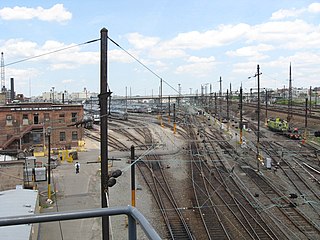
Sunnyside Yard is a large coach yard, a railroad yard for passenger cars in the Sunnyside neighborhood of Queens in New York City. The yard is owned by Amtrak and is also used by New Jersey Transit. The Pennsylvania Railroad (PRR) completed construction of the yard in 1910; it was originally the largest coach yard in the world, occupying 192 acres (0.78 km2).

Rosedale is a station on the Long Island Rail Road's Atlantic Branch. The station is located in the Rosedale neighborhood of Queens, New York City, at Sunrise Highway, Francis Lewis Boulevard, and 243rd Street. The station is included in the MTA's CityTicket program.

Far Rockaway is the terminus of the Long Island Rail Road's Far Rockaway Branch in the Far Rockaway neighborhood of Queens in New York City. The station is located at Nameoke Avenue and Redfern Avenue.

The City Terminal Zone is the set of Long Island Rail Road lines within New York City west of Jamaica station, except the Port Washington Branch.

The Montauk Branch is a rail line owned and operated by the Long Island Rail Road in the U.S. state of New York. The line runs the length of Long Island, 115 miles (185 km) from Long Island City to Montauk. However, in LIRR maps and schedules for public use, the term Montauk Branch refers to the line east of Babylon; service from Jamaica to Babylon is covered by separate Babylon Branch schedules, while the line west of Jamaica is currently unused for passenger service. A select number of Montauk Branch trains operate via the Main Line and Central Branch during peak hours.

The Long Island City station is a rail terminal of the Long Island Rail Road in the Hunters Point and Long Island City neighborhoods of Queens, New York City. Located within the City Terminal Zone at Borden Avenue and Second Street, it is the westernmost LIRR station in Queens and the end of both the Main Line and Montauk Branch. The station consists of one high-level passenger platform located at ground level and is wheelchair accessible.
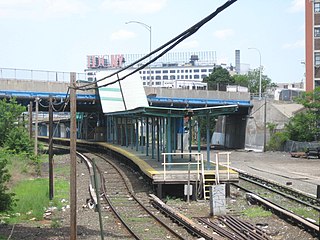
Hunterspoint Avenue is a station on the Main Line of the Long Island Rail Road, within the City Terminal Zone. It is located at 49th Avenue between 21st Street and Skillman Avenue in the Hunters Point and Long Island City neighborhoods of Queens, New York City. This ground-level station has an island platform between two tracks and is not wheelchair accessible from the entrance above the station.

The Central Branch is a rail line owned and operated by the Long Island Rail Road (LIRR) in the U.S. state of New York, extending from 40.734°N 73.470°W just east of Bethpage station to 40.696°N 73.341°W just west of Babylon station. It was built in 1873 as part of the Babylon Extension of the Central Railroad of Long Island (CRRLI), which was owned by Alexander Turney Stewart. The branch was mostly unused following the 1876 merger of the CRRLI and the LIRR, but in 1925 it was rebuilt and reconfigured to connect Bethpage and Babylon stations.
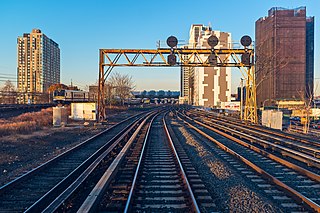
The Main Line is a rail line owned and operated by the Long Island Rail Road in the U.S. state of New York. It begins as a two-track line at Long Island City station in Long Island City, Queens, and runs along the middle of Long Island about 95 miles (153 km) to Greenport station in Greenport, Suffolk County. At Harold Interlocking approximately one mile east of Long Island City, the tracks from the East River Tunnels and 63rd Street Tunnel into Manhattan intersect with the Main Line, which most trains use rather than using the Long Island City station.
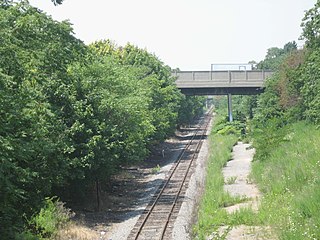
The Bay Ridge Branch is a rail line in New York City, owned by the Long Island Rail Road (LIRR) and operated by the New York and Atlantic Railway. It is the longest freight-only line of the LIRR, connecting the Montauk Branch and CSX Transportation's Fremont Secondary at Glendale, Queens, with the Upper New York Bay at Bay Ridge, Brooklyn.
The Long Island Rail Road is a railroad owned by the Metropolitan Transportation Authority in the U.S. state of New York. It is the oldest United States railroad still operating under its original name and charter. It consolidated several other companies in the late 19th century. The Pennsylvania Railroad owned the Long Island Rail Road for the majority of the 20th century and sold it to the State in 1966.

Rockaway Junction was a junction and station on the Long Island Rail Road's Main Line and Montauk Branch in Hillside, Queens, New York City, United States. It was located in the vicinity where the Montauk Branch now crosses over the two eastbound passenger tracks and the two freight tracks of the Main Line, just west of the Hillside Facility, although at the time of the station's existence it was at ground level along with the junction itself.
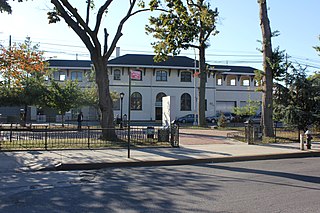
The Queens Village station is a commuter rail station on the Long Island Rail Road's Main Line, located between 218th Street and Springfield Boulevard, in the Queens Village neighborhood of Queens, New York City. It has two side platforms along the four-track line, and is served primarily by Hempstead Branch trains.

Fresh Pond was a small middle class neighborhood in the New York City borough of Queens, separated from Juniper Valley by the Lutheran and Mount Olivet cemeteries. In present day, it is now considered part of the surrounding neighborhoods of Maspeth, Middle Village, Glendale, and Ridgewood and is no longer referred to by the name "Fresh Pond." The area was originally named for two freshwater ponds that, in the early 1900s, were filled in. Other ponds were lower, and brackish due to Newtown Creek being estuarine.

The Bushwick Branch, also called the Bushwick Lead Track, is a freight railroad branch in New York City. It runs from the East Williamsburg neighborhood of Brooklyn to Fresh Pond Junction in the Glendale neighborhood of Queens, where it connects with the Montauk Branch of the Long Island Rail Road. It is owned by the LIRR but operated under lease by the New York and Atlantic Railway, which took over LIRR freight operations in May 1997.

Fresh Pond Junction is a freight yard in the Ridgewood and Glendale neighborhoods of Queens in New York City. It is operated by the New York & Atlantic Railway, which serves Long Island using tracks owned by the Long Island Rail Road (LIRR). The yard has operated since the early 20th century and is the primary rail freight yard on the island.
Sunnyside is a proposed commuter rail station to be served by the Long Island Rail Road and the Metro-North Railroad. Located in the Sunnyside neighborhood of Queens, New York, the station would be located within the City Terminal Zone. The proposed location of the station is at Queens Boulevard and Skillman Avenue.

Harold Interlocking is a large railroad junction in New York City. The busiest rail junction in the United States, it serves trains on Amtrak's Northeast Corridor and the Long Island Rail Road's Main Line and Port Washington Branch, which diverge at the junction.























